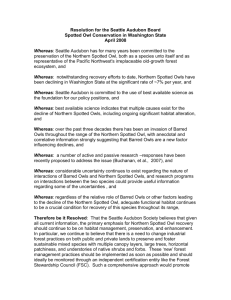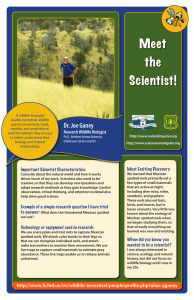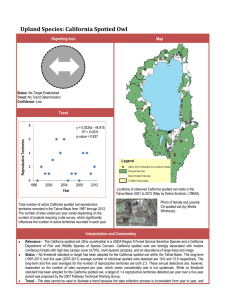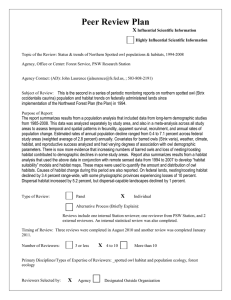Chapter 5: California Spotted Owls Introduction Summary of Findings
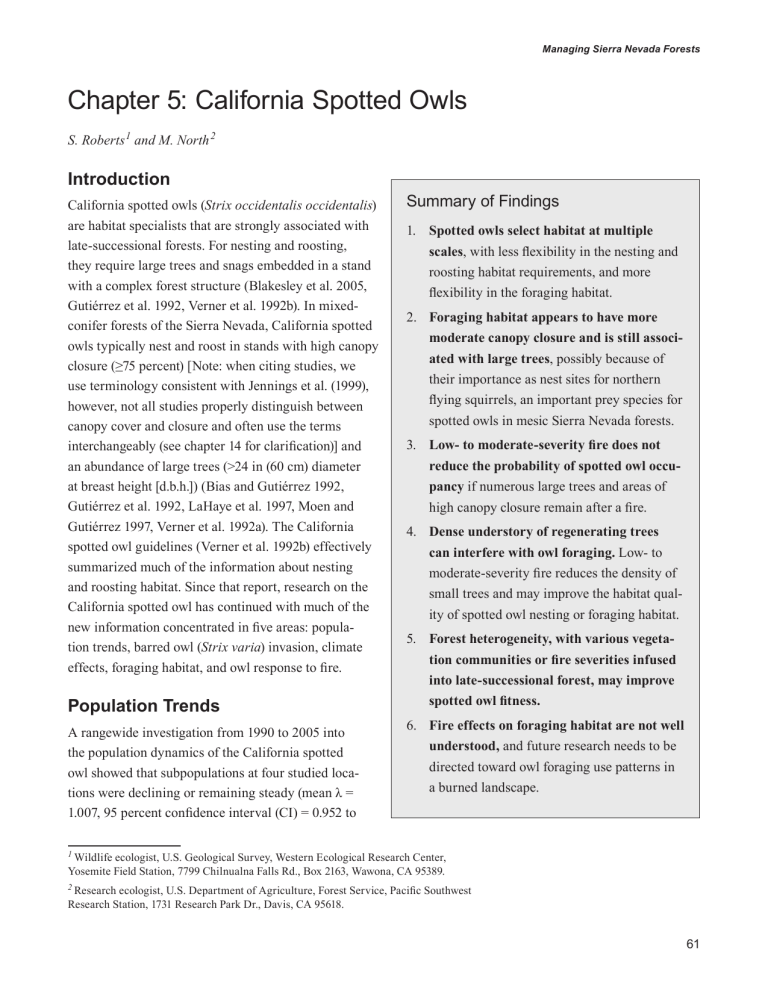
Managing Sierra Nevada Forests
Chapter 5: California Spotted Owls
S. Roberts
1
and M. North
2
Introduction
California spotted owls (
Strix occidentalis occidentalis
) are habitat specialists that are strongly associated with late-successional forests. For nesting and roosting, they require large trees and snags embedded in a stand with a complex forest structure (Blakesley et al. 2005,
Gutiérrez et al. 1992, Verner et al. 1992b). In mixedconifer forests of the Sierra Nevada, California spotted owls typically nest and roost in stands with high canopy closure (≥75 percent) [Note: when citing studies, we use terminology consistent with Jennings et al. (1999), however, not all studies properly distinguish between canopy cover and closure and often use the terms interchangeably (see chapter 14 for clarification)] and an abundance of large trees (>24 in (60 cm) diameter at breast height [d.b.h.]) (Bias and Gutiérrez 1992,
Gutiérrez et al. 1992, LaHaye et al. 1997, Moen and
Gutiérrez 1997, Verner et al. 1992a). The California spotted owl guidelines (Verner et al. 1992b) effectively summarized much of the information about nesting and roosting habitat. Since that report, research on the
California spotted owl has continued with much of the new information concentrated in five areas: population trends, barred owl (
Strix varia
) invasion, climate effects, foraging habitat, and owl response to fire.
Population Trends
A rangewide investigation from 1990 to 2005 into the population dynamics of the California spotted owl showed that subpopulations at four studied locations were declining or remaining steady (mean λ =
1.007, 95 percent confidence interval (CI) = 0.952 to
Summary of Findings
1.
Spotted owls select habitat at multiple scales
, with less flexibility in the nesting and roosting habitat requirements, and more flexibility in the foraging habitat.
2.
Foraging habitat appears to have more moderate canopy closure and is still associated with large trees
, possibly because of their importance as nest sites for northern flying squirrels, an important prey species for spotted owls in mesic Sierra Nevada forests.
3. Low- to moderate-severity fire does not reduce the probability of spotted owl occupancy
if numerous large trees and areas of high canopy closure remain after a fire.
4.
Dense understory of regenerating trees can interfere with owl foraging.
Low- to moderate-severity fire reduces the density of small trees and may improve the habitat quality of spotted owl nesting or foraging habitat.
5.
Forest heterogeneity, with various vegetation communities or fire severities infused into late-successional forest, may improve spotted owl fitness.
6.
Fire effects on foraging habitat are not well understood,
and future research needs to be directed toward owl foraging use patterns in a burned landscape.
1 Wildlife ecologist, U.S. Geological Survey, Western Ecological Research Center,
Yosemite Field Station, 7799 Chilnualna Falls Rd., Box 2163, Wawona, CA 95389.
2 Research ecologist, U.S. Department of Agriculture, Forest Service, Pacific Southwest
Research Station, 1731 Research Park Dr., Davis, CA 95618.
61
GENERAL TECHNICAL REPORT PSW-GTR-237
1.066) (Blakesley et al. 2010). Apparent survival was similar between the sexes and increased with owl age. The subpopulation residing in the only national park included in the meta-analysis, Sequoia-Kings Canyon (SEKI), showed the highest survival rates. Mean annual reproductive output (number of young fledged per territorial female) ranged from 0.988 (± 0.154) in the El Dorado National Forest to
0.555 (± 0.110) in SEKI. El Dorado showed the highest annual variation, with higher reproduction every second year, while SEKI had low annual variation. Although reproductive output varied between the four subpopulations, the El Dorado showed a declining trend. This declining trend is probably related to recent low annual reproduction and a consistent decrease in recruitment in the El Dorado. The high annual variation and decreasing trend observed in the El Dorado subpopulation indicate that habitat quality is not stable and probably decreasing over time. As with the northern spotted owl, reproductive output was highest with adults, followed by second-year subadults, and then first-year subadults. Population viability analyses indicated that the probability of a >10 percent decline in 7 years was lowest at 0.41
(95 percent CI = 0.09 to 0.78) for the Sierra National Forest subpopulation and highest at 0.64 (95 percent CI= 0.27 to 0.94) for the Lassen National Forest, and inconclusive for the El Dorado and SEKI (Blakesley et al. 2010).
Barred Owl
The barred owl, an aggressive competitor, has invaded the Sierra Nevada from the north and started reproducing as far south as the El Dorado National Forest
(Keane 2007). This invasion appears to be a natural biogeographical process (Dark et al. 1998). Once barred owls establish a population adjacent to spotted owls, there are negative effects on spotted owl metapopulation dynamics (Olson et al.
2005). Barred owls are habitat and diet generalists (Livezey 2007) and appear to outcompete spotted owls during the breeding season, displacing spotted owls from territories that they occupy (Hamer et al. 2007). Ishak et al. (2008) found that many spotted owls had a blood parasite not found in barred owls, which may further reduce spotted owl competiveness with the recent invader. In the Pacific Northwest, scientists and managers are currently trying to rapidly formulate methods for reducing the barred owls’ negative impacts on spotted owls (Buchanan et al. 2007).
Climate Change Effects
In the Pacific Northwest, Glenn et al. (2010) showed that the rate of population change (λ) for the northern spotted owl was positively influenced by wetter-thannormal growing seasons, which they speculated improved owl prey availability.
However, cold, wet winter and spring (early nesting season), as well as the number
62
Managing Sierra Nevada Forests of hot summer days, negatively affected the rate of population change. The influence of climate data on the rate of population change (λ) was highly variable, explaining 3 to 85 percent of the total variability seen in λ, across six different study areas. Adult survival, which was closely related to regional climate conditions, had a stronger influence on the rate of population change than recruitment, which was associated with local weather. As climate change models project warmer winters with higher variability in winter precipitation, and hotter, drier summers across the Pacific Northwest and northern California, climate could potentially have a rangewide negative effect on spotted owl survival, recruitment, and population growth rates. North et al. (2000) suggested that regional weather during the nesting season influenced reproductive success and nest-site canopy structure was important in mitigating the effects of detrimental weather. Carroll (2010) advised that models used for spotted owl conservation planning should incorporate habitat variables along with climate information.
Spotted Owl Nesting and Foraging
Habitat Characteristics
Generally, spotted owl survival increases with increasing area of late-successional forest (Dugger et al. 2005, Franklin et al. 2000, Olson et al. 2004) and decreases with increasing area of early successional forests (Dugger et al. 2005). However, because owls use a variety of habitats for foraging and nesting, forest heterogeneity across the landscape can improve spotted owl viability. Spotted owl survival and reproductive rates were higher in owl territories that included a mosaic of vegetation types infused within late-successional forest (Franklin et al. 2000), presumably because there was a greater diversity or abundance of prey within this mosaic
(Ward et al. 1998, Zabel et al. 1995).
Spotted owls select habitat at multiple spatial and temporal scales, with less flexibility in nesting and roosting habitat requirements than foraging habitat.
Blakesley et al. (2005) used remote sensing vegetation data to investigate the importance of spatial scale for spotted owl occupancy on a landscape scale. Between the two scales (500 and 2,000 ac) (202 to 809 ha) they found that the forest structure at the 500-ac (202-ha) scale was the most important. Within that scale, studies agree that both high overstory canopy closure and cover and an abundance of large trees are major influences in owl habitat selection (Bias and Gutiérrez 1992, Blakesley et al. 2005, Gutiérrez et al. 1992, LaHaye et al. 1997, Moen and Gutiérrez 1997, Roberts et al. 2011, Verner et al. 1992a). Reproduction can be associated with foraging habitat quality, because owls appear to fledge young more often as prey availability increases (Carey et al. 1992, Rosenberg et al. 2003). In northeastern California,
Because owls use a variety of habitats for foraging and nesting, forest heterogeneity across the landscape can improve spotted owl viability.
63
GENERAL TECHNICAL REPORT PSW-GTR-237 spotted owl reproduction was negatively correlated to nonforested areas and forest types not used for nesting or foraging within the nest area (500 acres) (Blakesley et al. 2005).
While foraging has been better studied for the northern spotted owl (
Strix occidentalis caurina
ex. Forsman et al. 2004), there are several emerging patterns applicable to California spotted owl foraging. For example, northern spotted owls may forage in or near edge habitat (Clark 2007, Folliard et al. 2000, Ward et al. 1998), but California spotted owls did not locate their nests close to edges (Phillips et al.
2010). For California spotted owls, foraging habitat appears to be more open (≥40 percent) than nesting habitat (≥70 percent) with respect to canopy closure (Call et al. 1992, Zabel et al. 1992), basal area (Roberts et al. 2011), and stand density (Irwin et al. 2007). Additionally, spotted owl foraging habitat is associated with large trees, possibly because of their importance as nest sites for northern flying squirrels
(
Glaucomys sabrinus
) (Meyer et al. 2005, Waters and Zabel 1995), an important prey species for spotted owls in mesic or closed-canopied Sierra Nevada forests
(Williams et al. 1992). Irwin et al. (2007) found owl foraging associated with forests in proximity to nest sites and small streams. In an analysis of owl locations including many foraging locations in the southern Sierra Nevada, owls used canyon/ stream bottoms significantly more than expected (Underwood et al. 2010). Riparian area use may be related to preferred forest structural conditions (i.e., large trees and high canopy closure) or possibly higher abundance of northern flying squirrels
(Meyer et al. 2005, 2007). In northern Sierra Nevada mixed-conifer forests, Innes et al. (2007) found higher densities of dusky-footed woodrats (
Neotoma fuscipes
), another preferred owl prey species, in areas with large black oaks (
Quercus kelloggii
Newberry). In general, these studies suggest that foraging habitat is (1) more open (less vegetation biomass) than nesting habitat, (2) often located close to nest sites, (3) associated with large trees and snags, and (4) infused with other vegetation types (e.g., riparian forests, black oak-dominated patches).
Spotted Owls and Fire
The late-successional, and often dense, forests favored by spotted owls for nesting and roosting are at risk to stand-replacing fires because of heavy fuel loading (Agee et al. 2000). Accumulated dead biomass and down woody debris can carry fire horizontally through the forest and vertically into the upper canopy (Tappeiner and
McDonald 1996, Weatherspoon and Skinner 1995). Such high fuel loading and vertically continuous ladder fuels put structurally complex, mature forests at greater risk of stand-replacing fire (Agee, 1993, North and Hurteau 2011, Weatherspoon et al. 1992). However, forest landscapes exposed to repeated burning are often
64
buffered from the effects of future wildfires and characterized by a mosaic of forest patches with high structural heterogeneity at multiple spatial scales (Collins et al.
2009, Stephens et al. 2008). This heterogeneity can improve spotted owl persistence by protecting late-successional patches from stand-replacing fire and potentially enhancing the abundance or diversity of prey species within an individual territory
(resulting from greater habitat diversity) (fig. 5-1).
Managing Sierra Nevada Forests
Figure 5-1—A California spotted owl nest in a mixed-conifer forest that burned in a prescribed fire with mixed fire severity in 1997 in
Yosemite National Park. Note the nest (shown by arrow) is in an area that burned at low severity and has high canopy closure. The nest is adjacent (<50 ft away) (<15.2 m) to an area (left one third of the photo) with lower closure that experienced moderate fire severity.
High fuel loading and ladder fuels can reduce foraging or nesting habitat quality for California spotted owls in Sierra Nevada forests. In a fire-suppressed forest, Blakesley et al. (2005) found that increasing the proportion of smaller trees
(<23 in d.b.h.) (<60 cm) around the nest, even with high overstory canopy cover
(>70 percent), can negatively influence owl occupancy. Decades of fire suppression created a dense understory of regenerating white fir (
Abies concolor
(Gordon &
Glend.) Lindley), and these thickets of young trees could interfere with owl foraging in high-use areas. Roberts et al. (2011) found that scattered small trees did not negatively affect owl occupancy in forests where managers allowed low- to moderate-severity fire to periodically clear out these thickets and leave behind large, live trees while retaining high overstory canopy closure. Scattered pockets of small- and medium-diameter trees (4 to 20 in d.b.h.) (10 to 50 cm) can contribute to a multilayered canopy that may allow for efficient thermoregulation for spotted owls, which are not well adapted to heat exposure (Barrows 1981, Weathers et al.
2001). In contrast, Clark (2007) showed that northern spotted owl occupancy and annual survival rates declined (Clark et al. 2011), and annual home range and local extinction increased immediately following (1 to 4 years) wildfire. Clark (2007) also found that annual home range size increased with increasing amount of hard edge (e.g., logging or fire boundaries) within the home range, suggesting lower
Scattered pockets of small- and medium-diameter trees can contribute to a multilayered canopy that may allow for efficient thermoregulation for spotted owls.
65
GENERAL TECHNICAL REPORT PSW-GTR-237 quality habitat within fragmented sites. Postfire salvage logging and large areas of early-seral forests in his study area, however, may have confounded his observed occupancy rates.
Fire effects on foraging habitat are not well understood. Clark (2007) observed
23 northern spotted owls using all types of fire severity in southern Oregon. However, within burned areas, owls strongly selected low-severity or unburned areas with minimal overstory canopy mortality. In this burned landscape, owl high-use areas were characterized by lower fire severity and greater structural diversity.
Clark (2007) also found that postfire salvage logging reduced owl habitat quality.
In contrast, Bond et al. (2009) followed seven owls (three pairs and an individual) using a 4-year-old burned forest in southern Sierra Nevada and found higher than expected owl foraging in high-severity burn areas. The study, however, is limited by its small sample size, brief period of study (12 weeks), and nonrandom owl selection. Additionally, studies of deer mice (
Peromyscus maniculatus
) and other spotted owl prey in Yosemite National Park indicate that deer mouse abundance was negatively associated with increasing fire severity (Roberts et al. 2011). Collectively, these studies suggest the presence of large trees and high overstory canopy closure are the most important pre- and postfire conditions associated with spotted owl occupancy.
References
Agee, J.K. 1993.
Fire ecology of Pacific Northwest forests. Washington, DC:
Island Press. 505 p.
Agee, J.K.; Bahro, B.; Finney, M.A.; Omi, P.N.; Sapsis, D.B.; Skinner, C.N.; van Wagtendonk, J.W.; Weatherspoon, C.P. 2000.
The use of fuel breaks in landscape fire management. Forest Ecology and Management. 127: 55–66.
Barrows, C.W. 1981.
Roost selection by spotted owls: an adaptation to heat stress.
The Condor. 83: 302–309.
Bias, M.A.; Gutiérrez, R.J. 1992.
Habitat association of California spotted owls in the central Sierra Nevada. Journal of Wildlife Management. 56: 584–595.
Blakesley, J.A.; Noon, B.R.; Anderson, D.R. 2005.
Site occupancy, apparent survival, and reproduction of California spotted owls in relation to forest stand characteristics. Journal of Wildlife Management. 69: 1554–1654.
66
Blakesley, J.A.; Seamans, M.E.; Conner, M.M.; Franklin, A.B.; White, G.C.;
Gutiérrez, R.J.; Hines, J.E.; Nichols, J.D.; Munton, T.E.; Shaw, D.W.H.;
Keane, J.J.; Steger, G.N.; McDonald, T.L. 2010.
Population dynamics of spotted owls in the Sierra Nevada, California. Wildlife Monographs. 174: 1–36.
Bond, M.L.; Lee, D.E.; Siegel, R.B.; Ward, J.P. 2009.
Habitat use and selection by California spotted owls in a postfire landscape. Journal of Wildlife
Management. 73: 1116–1124.
Buchanan, J.B.; Gutiérrez, R.J.; Anthony, R.G.; Cullinan, T.; Diller, L.V.;
Forsman, E.D.; Franklin, A.B. 2007.
A synopsis of suggested approaches to address potential competitive interactions between barred owls (
Strix varia
) and spotted owls (
S. occidentalis
). Biological Invasions. 6: 679–691.
Call, D.R.; Gutiérrez, R.J.; Verner, J. 1992.
Foraging habitat and home-range characteristics of California spotted owls in the Sierra Nevada. Condor.
94: 880–888.
Carey, A.B.; Horton, S.P.; Biswell, B.L. 1992.
Northern spotted owls: influence of prey base and landscape character. Ecological Monographs. 62: 223–250.
Carroll, C. 2010.
Role of climatic niche models in focal-species-based conservation planning: assessing potential effects of climate change on northern spotted owl in the Pacific Northwest, USA. Biological Conservation. 143: 1432–1437.
Clark, D.A. 2007.
Demography and habitat selection of northern spotted owls in post-fire landscapes of southwestern Oregon. Corvallis, OR: Oregon State
University. 202 p. M.S. thesis.
Clark, D.A.; Anthony, R.G.; Andrews, L.S. 2011.
Survival rates of northern spotted owls in post-fire landscapes of southwest Oregon. Journal of Raptor
Research. 45: 38–47.
Collins, B.M.; Miller, J.D.; Thode, A.E.; Kelly, M.; van Wagtendonk, J.W.;
Stephens, S.L. 2009.
Interactions among wildland fires in a long-established
Sierra Nevada natural fire area. Ecosystems. 12: 114–128.
Dark, S.J.; Gutiérrez, R.J.; Gould, G.I., Jr. 1998.
The barred owl (
Strix varia
) invasion in California. The Auk. 115: 50–56.
Dugger, K.M.; Wagner, F.; Anthony, R.G.; Olson, G.S. 2005.
The relationship between habitat characteristics and demographic performance of northern spotted owls in southern Oregon. Condor. 107: 863–878.
Managing Sierra Nevada Forests
67
GENERAL TECHNICAL REPORT PSW-GTR-237
Folliard, L.B.; Reese, K.; Diller, L.V. 2000.
Landscape characteristics of northern spotted owl nest sites in northwestern California. Journal of Raptor Research.
34: 75–84.
Forsman, E.D.; Anthony, R.G.; Meslow, E.C.; Zabel, C.J. 2004.
Diet and foraging behavior of northern spotted owls in Oregon. Journal of Raptor
Research. 38: 214–230.
Franklin, A.B.; Gutiérrez, R.J.; Burnham, K.P. 2000.
Climate, habitat quality, and fitness in northern spotted owl populatoin in northwest California.
Ecological Monographs. 70: 539–590.
Glenn, E.M.; Anthony, R.G.; Forsman, E.D. 2010.
Population trends in northern spotted owls: associations with climate in the Pacific Northwest. Biological
Conservation. 143: 2543–2552.
Gutiérrez, R.J.; Verner, J.; McKelvey, K.S.; Noon, B.R.; Steger, G.N.; Call,
D.R.; LaHaye, W.S.; Bingham, B.B.; Senser, J.S. 1992.
Habitat relations of the
California spotted owl. In: Verner, J.; McKelvey, K.S.; Noon, B.R.; Gutiérrez,
R.J.; Gould, G.I., Jr.; Beck, T.W., tech. coords. The California spotted owl: a technical assessment of its current status. Gen. Tech. Rep. PSW-GTR-133.
Albany, CA: U.S. Department of Agriculture, Forest Service, Pacific Southwest
Research Station: 79–98.
Hamer, T.E.; Forsman, E.D.; Glenn, E.M.; Elizabeth, M. 2007.
Home range attributes and habitat selection of barred owls and spotted owls in an area of sympatry. The Condor. 109: 750–768.
Innes, R.J.; Van Vuren, D.H.; Kelt, D.A.; Johnson, M.L.; Wilson, J.A.; Stine,
P.A. 2007.
Habitat associations of dusky-footed woodrats (
Neotonia fuscipes
) in mixed-conifer forest of the northern Sierra Nevada. Journal of Mammalogy.
88: 1523–1531.
Irwin, L.L.; Clark, L.A.; Rock, D.C.; Rock, S.L. 2007.
Modeling foraging habitat of California spotted owls. Journal of Wildlife Management.
71: 1183–1191.
Ishak, H.D.; Dumbacher, J.P.; Anderson, N.L.; Keane, J.J.; Valkiunas, G.;
Haig, S.M.; Tell, L.A.; Sehgal, R.N.M. 2008.
Blood parasites in owls with conservation implications for the spotted owl (
Strix occidentalis
). PLOS One.
3: e2304.
68
Keane, J. 2007.
Personal communication. Research wildlife biologist, U.S.
Department of Agriculture, Forest Service, Pacific Southwest Research Station,
1731 Research Park Dr., Davis, CA 95618.
LaHaye, W.S.; Gutiérrez, R.J.; Call, D.R. 1997.
Nest-site selection and reproductive success of California spotted owls. Wilson Bulletin. 109: 42–51.
Livezey, K.B. 2007.
Barred owl habitat and prey: a review and synthesis of the literature. Journal of Raptor Research. 41: 177–201.
Meyer, M.D.; Kelt, D.A.; North, M.P. 2005.
Nest trees of northern flying squirrels in the Sierra Nevada. Journal of Mammalogy. 86: 275–280.
Meyer, M.D.; Kelt, D.A.; North, M.P. 2007.
Microhabitat associations of northern flying squirrels in burned and thinned forest stands of the Sierra Nevada.
American Midland Naturalist. 157: 202–211.
Moen, C.A.; Gutiérrez, R.J. 1997.
California spotted owl habitat selection in the central Sierra Nevada. Journal of Wildlife Management. 61: 1281–1287.
North, M.P.; Steger, G.N.; Denton, R.; Eberlein, G.; Munton, T.E.; Johnson, K.
2000.
Association of weather and nest-site structure with reproductive success in
California spotted owls. Journal of Wildlife Management. 64: 797–807.
North, M.P.; Hurteau, M.D. 2011.
High-severity wildfire effects on carbon stocks and emissions in fuels treated and untreated forest. Forest Ecology and
Management. 261: 1115–1120.
Olson, G.S.; Glenn, E.M.; Anthony, R.G.; Forsman, E.D.; Reid, J.A.;
Loschl, P.J.; Ripple, W.J. 2004.
Modeling of demographic performance of northern spotted owls relative to forest habitat in Oregon. Journal of Wildlife
Management. 68: 1039–1053.
Olson, G.S.; Anthony, R.G.; Forsman, E.D.; Ackers, S.H.; Loschl, P.J.; Reid,
J.A.; Dugger, K.M.; Glenn, E.M.; Ripple, W.J. 2005.
Modeling of site occupancy dynamics for northern spotted owls, with emphasis on the effects of barred owls. Journal of Wildlife Management. 69: 918–932.
Phillips, C.E.; Tempel, D.J.; Gutiérrez, R.J. 2010.
Do California spotted owls select nest trees close to forest edges? Journal of Raptor Research. 44: 311–314.
Roberts, S.L.; van Wagtendonk, J.W.; Miles, A.K.; Kelt, D.A. 2011.
Effects of fire on spotted owl site occupancy in a late-successional forest. Biological
Conservation. 144: 610–619.
Managing Sierra Nevada Forests
69
GENERAL TECHNICAL REPORT PSW-GTR-237
Rosenberg, D.K.; Swindle, K.A.; Anthony, R.G. 2003.
Influence of prey abundance on spotted owl reproductive success in western Oregon. Canadian
Journal of Zoology. 81: 1715–1725.
Stephens, S.L.; Fry, D.; Franco-Vizcano, E. 2008.
Wildfire and forests in northwestern Mexico: the United States wishes it had similar fire problems.
Ecology and Society. 13: 10.
Tappeiner, J.C.; McDonald, P.M. 1996.
Regeneration of Sierra Nevada forests. In:
Sierra Nevada Ecosystem Project; final report to Congress. Vol. II: Assessments and scientific basis for management options. Davis, CA: University of California,
Center for Water and Wildland Resources: 501–512.
Underwood, E.C.; Viers, J.H.; Quinn, J.F.; North, M.P. 2010.
Using topography to meet wildlife and fuels treatment objectives in fire-suppressed landscapes.
Journal of Environmental Management. 46: 809–819.
Verner, J.; Gutiérrez, R.J.; Gould, G.I., Jr. 1992a.
The California spotted owl: general biology and ecological relations. In: Verner, J.; McKelvey, K.S.; Noon,
B.R.; Gutiérrez, R.J.; Gould, G.I., Jr.; Beck, T.W., tech. coords. The California spotted owl: a technical assessment of its current status. Gen. Tech. Rep. PSW-
GTR-133. Albany, CA: U.S. Department of Agriculture, Forest Service, Pacific
Southwest Research Station: 55–77.
Verner, J.; McKelvey, K.S.; Noon, B.R.; Gutiérrez, R.J.; Gould, G.I., Jr.; Beck,
T.W. 1992b.
Assessment of the current status of the California spotted owl, with recommendations for management. In: Verner, J.; McKelvey, K.S.; Noon, B.R.;
Gutiérrez, R.J.; Gould, G.I., Jr.; Beck, T.W., tech. coords. The California spotted owl: a technical assessment of its current status. Gen. Tech. Rep. PSW-GTR-133.
Albany, CA: U.S. Department of Agriculture, Forest Service, Pacific Southwest
Research Station: 3–26.
Ward, J.P., Jr.; Gutiérrez, R.J.; Noon, B.R. 1998.
Habitat selection by northern spotted owls: the consequences of prey selection and distribution. The Condor.
100: 79–92.
Waters, J.R.; Zabel, C.J. 1995.
Northern flying squirrel densities in fir forests of northeastern California. Journal of Wildlife Management. 59: 858–866.
Weathers, W.W.; Hodum, P.J.; Blakesley, J.A. 2001.
Thermal ecology and ecological energetics of California spotted owls. The Condor. 103: 678–690.
70
Weatherspoon, C.P.; Husari, S.J.; van Wagtendonk, J.W. 1992.
Fire and fuels management in relation to owl habitat in forests of the Sierra Nevada and southern California. In: Verner, J.; McKelvey, K.S.; Noon, B.R.; Gutiérrez, R.J.;
Gould, G.I., Jr.; Beck, T.W., tech. coords. The California spotted owl: a technical assessment of its current status. Gen. Tech. Rep. PSW-GTR-133. Albany, CA:
U.S. Department of Agriculture, Forest Service, Pacific Southwest Research
Station: 247–260.
Weatherspoon, C.P.; Skinner, C.N. 1995.
An assessment of factors associated with damage to tree crowns from the 1987 wildfires in northern California.
Forest Science. 41: 430–451.
Williams, D.F.; Verner, J.; Sakai, H.F.; Waters, J.R. 1992.
General biology of prey species of the California spotted owl. In: Verner, J.; McKelvey, K.S.; Noon,
B.R.; Gutiérrez, R.J.; Gould, G.I., Jr.; Beck, T.W., tech. coords. The California spotted owl: a technical assessment of its current status. Gen. Tech. Rep. PSW-
GTR-133. Albany, CA: U.S. Department of Agriculture, Forest Service, Pacific
Southwest Research Station: 207–221.
Zabel, C.J.; Steger, G.N.; McKelvey, K.S.; Eberlein, G.P.; Noon, B.R.; Verner,
J. 1992.
Home-range size and habitat-use patterns of California spotted owls in the Sierra Nevada. In: Verner, J.; McKelvey, K.S.; Noon, B.R.; Gutiérrez, R.J.;
Gould, G.I., Jr.; Beck, T.W., tech. coords. The California spotted owl: a technical assessment of its current status. Gen. Tech. Rep. PSW-GTR-133. Albany, CA:
U.S. Department of Agriculture, Forest Service, Pacific Southwest Research
Station: 149–163.
Zabel, C.J.; McKelvey, K.S.; Ward, J.P., Jr. 1995.
Influence of primary prey on home-range size and habitat-use patterns of northern spotted owls (
Strix occidentalis caurina
). Canadian Journal of Zoology. 73: 433–439.
Managing Sierra Nevada Forests
71

